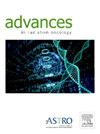Clinical Parameters Associated With Intracranial Progression Burden Following an Initial Stereotactic Radiosurgery Course in a Multi-institutional Brain Metastases Cohort
IF 2.7
Q3 ONCOLOGY
引用次数: 0
Abstract
Purpose
Following initial stereotactic radiosurgery (SRS), risk factors for high-burden intracranial progression (ICP) necessitating whole brain radiation remain poorly characterized. We hypothesize that specific clinical parameters at initial SRS are associated with high-burden ICP—defined as either ≥5 brain metastases (BMs) (ICP5) or ≥11 BMs (ICP11).
Materials and Methods
Across 2 institutions, we retrospectively identified all patients completing an initial SRS course from January 2015 to December 2020. ICP was defined as any radiographic concern for distant and/or in-field progression. Overall survival (OS) and freedom from ICP were estimated via the Kaplan-Meier method. Cox models assessed the association between clinical parameters and freedom from ICP5 and ICP11.
Results
We identified 1383 patients completing SRS. Post-SRS ICP was identified for 555 (40.1%) patients: 72.6% had 1 to 4 progressive BMs, 11.5% had 5 to 10 BMs, and 15.9% had ≥11 new BMs. Among these groups, 12-month OS was 56.8% (95% CI: 52.1%-61.9%), 46.0% (95% CI: 35.1%-60.1%), and 38.7% (95% CI: 29.4%-50.9%), respectively (P < .001). Neurologic symptoms at ICP were observed in 21.1%, 28.1%, and 50.0% of cases, respectively (P < .001). Oligometastatic disease at the time of SRS [ICP5: hazard ratio (HR) 0.68, 95% CI: 0.47-0.99; ICP11: 0.59; 95% CI: 0.36-0.97], no pre-SRS immunotherapy (ICP11: HR 1.74, 95% CI: 1.03-2.97), receipt of post-SRS immunotherapy (ICP5: HR 0.60, 95% CI: 0.402-0.906; ICP11: HR 0.57, 95% CI: 0.332-0.988), and a single BM at initial SRS (1 vs 2 BM, ICP 5: HR 0.51, 95% CI: 0.31-0.82; ICP11: HR 0.45, 95% CI: 0.24-0.84) were negative predictive factors of high-burden ICP.
Conclusions
High-burden ICP was associated with decreased OS and neurologic decline. Patients who had oligometastatic disease, who received post-SRS immunotherapy, who did not receive pre-SRS immunotherapy, and who had a single BM had improved freedom from high-burden ICP. These findings may justify consideration of upfront whole brain radiation for those at risk for high-burden ICP and prospective analysis of short-interval post-SRS surveillance in this population.
在多机构脑转移队列中,初始立体定向放射治疗过程后与颅内进展负担相关的临床参数
目的:在初始立体定向放射手术(SRS)后,需要全脑放射治疗的高负荷颅内进展(ICP)的危险因素仍不清楚。我们假设初始SRS的特定临床参数与高负荷icp相关-定义为≥5个脑转移瘤(ICP5)或≥11个脑转移瘤(ICP11)。材料和方法回顾性分析了2015年1月至2020年12月间完成初始SRS疗程的所有患者。ICP被定义为对远处和/或现场进展的任何影像学关注。通过Kaplan-Meier法估计总生存期(OS)和ICP自由度。Cox模型评估了临床参数与ICP5和ICP11自由度之间的关系。结果1383例患者完成了SRS。555例(40.1%)患者在srs后发现ICP: 72.6%有1 - 4个进展性脑转移,11.5%有5 - 10个脑转移,15.9%有≥11个新发脑转移。在这些组中,12个月OS分别为56.8% (95% CI: 52.1%-61.9%)、46.0% (95% CI: 35.1%-60.1%)和38.7% (95% CI: 29.4%-50.9%) (P <;措施)。颅内压患者出现神经系统症状的比例分别为21.1%、28.1%和50.0% (P <;措施)。SRS时的低转移性疾病[ICP5:风险比(HR) 0.68, 95% CI: 0.47-0.99;ICP11: 0.59;95% CI: 0.36-0.97],未接受srs前免疫治疗(ICP11: HR 1.74, 95% CI: 1.03-2.97),接受srs后免疫治疗(ICP5: HR 0.60, 95% CI: 0.402-0.906;ICP11: HR 0.57, 95% CI: 0.332-0.988)和初始SRS时单一BM (1 vs 2 BM, icp5: HR 0.51, 95% CI: 0.31-0.82;ICP11: HR 0.45, 95% CI: 0.24-0.84)为高负荷ICP的阴性预测因素。结论高负荷颅内压与OS降低和神经功能下降有关。患有少转移性疾病、接受srs后免疫治疗、未接受srs前免疫治疗和单一BM的患者可改善高负担ICP的自由度。这些发现可能证明,对于那些有高负担ICP风险的患者,应考虑进行全脑放疗,并对这一人群进行短间隔srs后监测的前瞻性分析。
本文章由计算机程序翻译,如有差异,请以英文原文为准。
求助全文
约1分钟内获得全文
求助全文
来源期刊

Advances in Radiation Oncology
Medicine-Radiology, Nuclear Medicine and Imaging
CiteScore
4.60
自引率
4.30%
发文量
208
审稿时长
98 days
期刊介绍:
The purpose of Advances is to provide information for clinicians who use radiation therapy by publishing: Clinical trial reports and reanalyses. Basic science original reports. Manuscripts examining health services research, comparative and cost effectiveness research, and systematic reviews. Case reports documenting unusual problems and solutions. High quality multi and single institutional series, as well as other novel retrospective hypothesis generating series. Timely critical reviews on important topics in radiation oncology, such as side effects. Articles reporting the natural history of disease and patterns of failure, particularly as they relate to treatment volume delineation. Articles on safety and quality in radiation therapy. Essays on clinical experience. Articles on practice transformation in radiation oncology, in particular: Aspects of health policy that may impact the future practice of radiation oncology. How information technology, such as data analytics and systems innovations, will change radiation oncology practice. Articles on imaging as they relate to radiation therapy treatment.
 求助内容:
求助内容: 应助结果提醒方式:
应助结果提醒方式:


